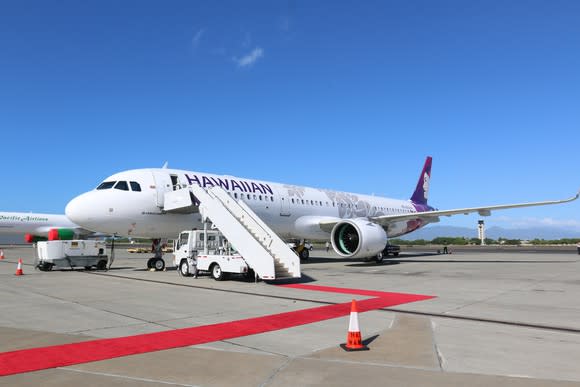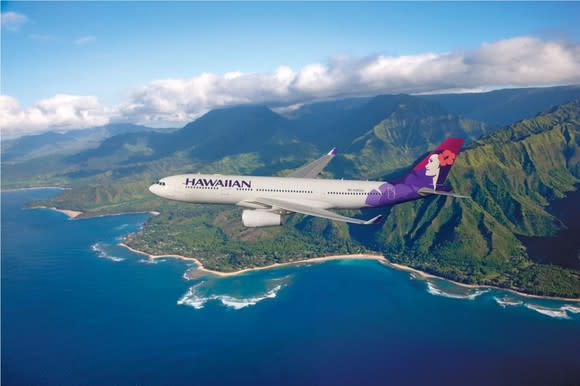The Best Airline Stock to Own if Fuel Prices Stay High
Entering 2018, airlines expected to face significant profit headwinds from higher fuel costs, after oil prices soared nearly 50% in the second half of 2017.
Unfortunately, oil prices have continued to move higher in 2018, particularly since March. This has already forced American Airlines to cut its earnings-per-share forecast for 2018. Barring a reversal in the energy markets, other airlines are likely to follow suit in the coming months.
However, one U.S. airline is uniquely suited to weather the current environment of rising fuel prices: Hawaiian Holdings (NASDAQ: HA). Furthermore, Hawaiian Holdings stock trades for just seven times forward earnings, which makes this company a particularly attractive investment opportunity.
Fuel hedges intact at Hawaiian Airlines
Fuel hedging is one reason Hawaiian Airlines won't face as big a profit headwind from rising oil prices as its rivals. Many U.S. airlines have phased out their fuel hedging programs over the past few years, after having been burned by the 2014-2016 plunge in oil prices. But as a smaller carrier, Hawaiian decided to continue its relatively modest fuel hedging program in order to reduce its vulnerability to oil price shocks.

Unlike most airlines, Hawaiian Airlines still hedges its fuel costs. Image source: Hawaiian Airlines.
Not surprisingly, this strategy didn't pay off in the past couple of years. Hawaiian Airlines reported $27.6 million of settled hedge losses in 2016 and $534,000 of settled hedge losses in 2017. However, the recent surge in oil prices has changed the equation completely.
In the first quarter, Hawaiian had a realized gain of $5.7 million from fuel hedges. As of the end of the quarter, its remaining fuel hedges -- most of which cover the last nine months of 2018 -- had a market value of $19.7 million.
Oil prices (and jet fuel prices) have increased by more than $0.20 per gallon since the end of the first quarter. If that price level holds, Hawaiian Airlines would likely recognize an additional $20 million or more of hedge gains during the remainder of 2018. Including the $5.7 million gain realized in the first quarter and the $19.7 million of hedging gains on the books as of March 31, Hawaiian's 2018 hedging gains could boost its pre-tax margin by at least 1.5 percentage points.
Fuel surcharges will boost revenue
In theory, airlines should react to rising fuel prices by raising fares to offset cost increases. In practice, industry competitive dynamics rather than fuel costs have been the main driver of fare levels recently. In some markets, airlines have been able to recover their fuel cost increases. In others, stiff competition has held fares down.
However, a few international markets -- most notably, Japan -- have fuel surcharges that adjust automatically over time based on the price of jet fuel (albeit with a lag). Hawaiian Airlines gets about 15% of its revenue from Japan, so rising fuel surcharges there are a big unit revenue tailwind for the carrier. Last quarter, unit revenue surged 11.9% year over year in Hawaiian's international markets. Management estimated that fuel surcharges increased unit revenue by about 1 percentage point on a companywide basis.

Hawaiian Airlines has a major presence in Japan. Image source: Hawaiian Airlines.
For tickets purchased between August 2017 and November 2017, the fuel surcharge on flights between Japan and Hawaii was just 2,000 yen one-way. The surcharge rose to 4,000 yen in December and has been set at 6,000 yen (about $55 since the beginning of February.
The recent surge in jet fuel prices will drive fuel surcharges higher later this year. The price of jet fuel has averaged more than 9,000 yen per barrel over the past two months, which will cause the one-way fuel surcharge to reach 8,500 yen for tickets purchased in August and September (up from 2,000 yen a year earlier).
In the past week or so, Singapore jet fuel prices have surpassed 10,000 yen per barrel. If prices stay at this level or rise further in the next two months, the fuel surcharge would reach 11,000 yen (approximately $100) one-way for tickets bought in October and November. As a result, the year-over-year unit revenue tailwind from higher surcharges could easily double to 2 percentage points by the fourth quarter of this year.
Primed for strong profits
Hawaiian Airlines certainly isn't immune to rising fuel prices. But while most of its rivals are facing a roughly 6-percentage-point margin headwind from rising fuel costs this year, Hawaiian Airlines is on track to recover about half of that amount from fuel hedging gains and higher fuel surcharges on international routes. Meanwhile, strong demand has kept fares quite stable in the West Coast-Hawaii market, despite a surge in competition there this year.
Analysts currently expect Hawaiian Holdings' adjusted EPS to rise 9% in 2018, relative to the company's restated 2017 results. Apparently, they expect higher fuel costs (and perhaps also higher competition in the West Coast-Hawaii market) to offset most of the 25%-30% benefit from a lower tax rate and a lower share count.
This seems too pessimistic. Rising fuel surcharges and fuel hedging gains should enable stronger EPS growth at Hawaiian Holdings, which could enable the stock to rally later this year.
More From The Motley Fool
Adam Levine-Weinberg owns shares of Hawaiian Holdings. The Motley Fool has no position in any of the stocks mentioned. The Motley Fool has a disclosure policy.

 Yahoo Finance
Yahoo Finance 